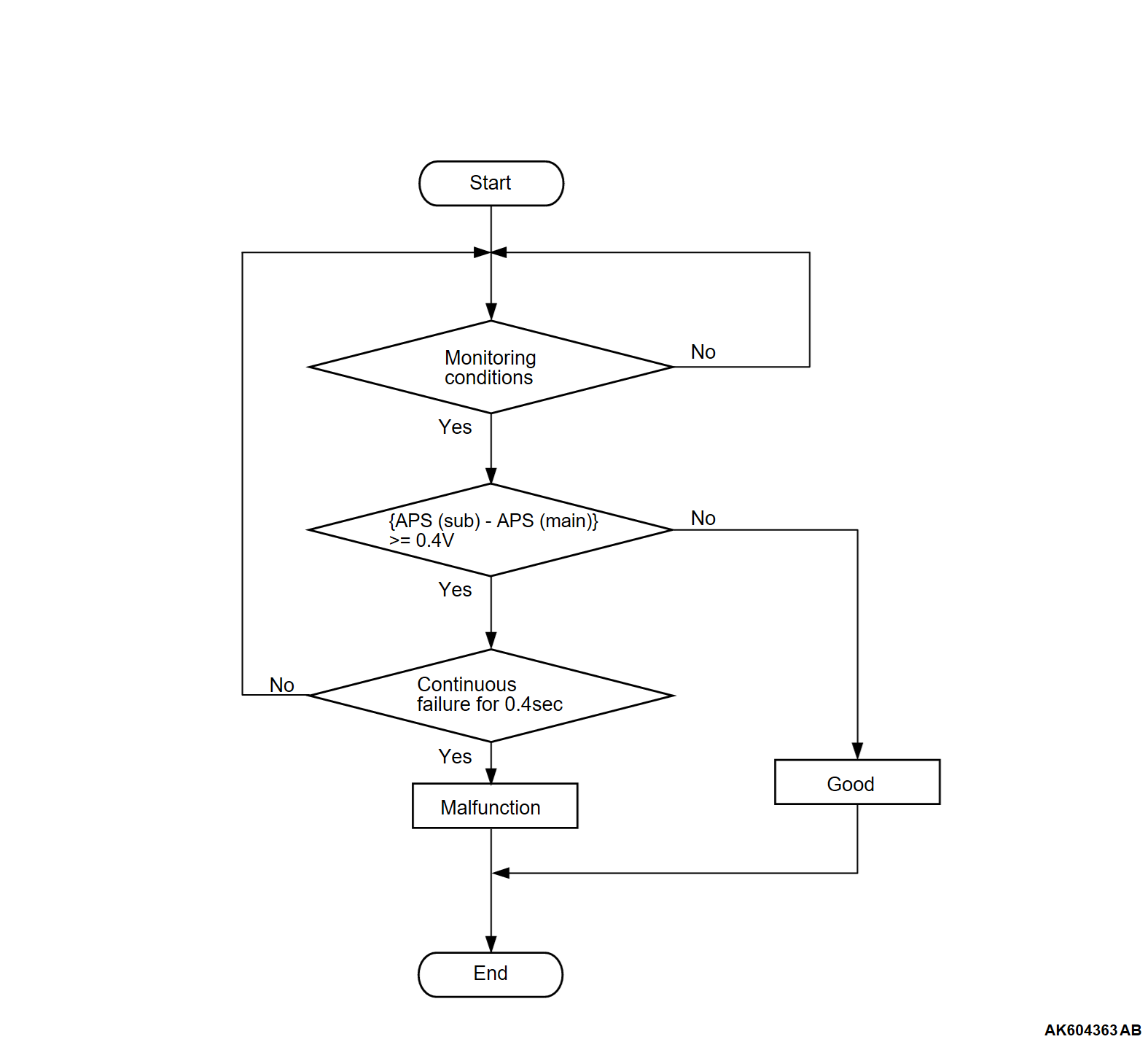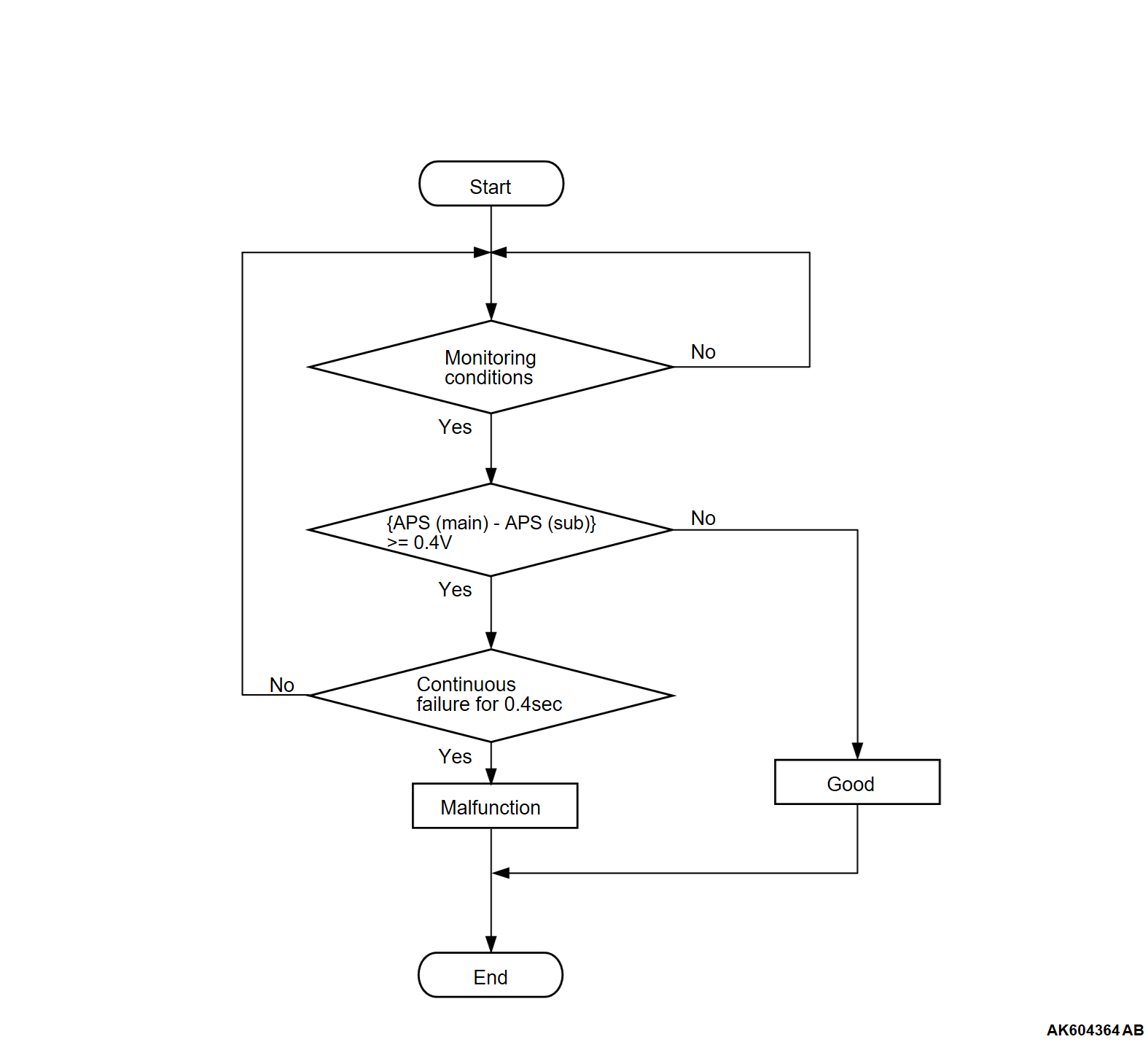DTC P2138: Accelerator Pedal Position Sensor (main and sub) Circuit Range/Performance Problem
ACCELERATOR PEDAL POSITION SENSOR (main and sub) RANGE/PERFORMANCE PROBLEM CIRCUIT
CIRCUIT OPERATION
TECHNICAL DESCRIPTION
ECM checks the accelerator pedal position sensor output signal characteristics for abnormal conditions.
DESCRIPTIONS OF MONITOR METHODS
Detect malfunction if the relation between accelerator pedal position sensor (main) and accelerator pedal position sensor (sub) is wrong.
MONITOR EXECUTION
- Continuous
MONITOR EXECUTION CONDITIONS (Other monitor and Sensor)
Other Monitor (There is no temporary DTC set in memory for the item monitored below)
- Not applicable
Sensor (The sensor below is determined to be normal)
- Not applicable
Check Condition
- Ignition switch is "ON" position.
Judgment Criterion
- Voltage obtained with the formula given below is 0.4 volt or higher for 0.4 second: [accelerator pedal position sensor (sub) voltage - accelerator pedal position sensor (main) voltage].
note The accelerator pedal position sensor voltage used for the judgment is converted into the accelerator pedal position sensor voltage for the internal processing by the ECM.
Check Condition
- Ignition switch is "ON" position.
Judgment Criterion
- Voltage obtained with the formula given below is 0.4 volt or higher for 0.4 second: [accelerator pedal position sensor (main) voltage - accelerator pedal position sensor (sub) voltage].
note The accelerator pedal position sensor voltage used for the judgment is converted into the accelerator pedal position sensor voltage for the internal processing by the ECM.
FAIL-SAFE AND BACKUP FUNCTION
- Throttle opening degree is restricted.
- Throttle opening degree position is in default position if accelerator pedal position sensor (sub) fails.
TROUBLESHOOTING HINTS (The most likely causes for this code to be set are:)
- Accelerator pedal position sensor failed.
- Accelerator pedal position sensor circuit, harness damage or connector damage.
- ECM failed.
DIAGNOSIS
STEP 1. Check the continuity at accelerator pedal position sensor harness side connector.
(1) Disconnect the accelerator pedal position sensor connector and measure at the harness side.
(2) Check for the continuity between terminal APSE line and ground.
- Continuity (2 ohms or less)
Does continuity exist?
STEP 2. Check of harness damage in APSE line between accelerator pedal position sensor connector and ECM connector.
Is the harness wire in good condition?
STEP 3. Check the trouble symptoms.
(1) Carry out a test drive with the drive cycle pattern. Refer to Diagnostic Function - OBD-II Drive Cycle - Pattern 1  .
.
 .
.(2) Check the diagnostic trouble code (DTC).
Is DTC P2138 set?
STEP 4. Check the continuity at accelerator pedal position sensor harness side connector.
(1) Disconnect the accelerator pedal position sensor connector and measure at the harness side.
(2) Check for the continuity between terminal APE line and ground.
- Continuity (2 ohms or less)
Does continuity exist?
STEP 5. Check of harness damage in APE line between accelerator pedal position sensor connector and ECM connector.
Is the harness wire in good condition?
STEP 6. Check of harness damage in APS5 line between accelerator pedal position sensor connector and ECM connector.
Is the harness wire in good condition?
STEP 7. Check of harness damage in AP5 line between accelerator pedal position sensor connector and ECM connector.
Is the harness wire in good condition?
STEP 8. Check of harness damage in APSM line between accelerator pedal position sensor connector and ECM connector.
Is the harness wire in good condition?
STEP 9. Check of harness damage in APSS line between accelerator pedal position sensor connector and ECM connector.
Is the harness wire in good condition?
![[Previous]](../../../buttons/fprev.png)
![[Next]](../../../buttons/fnext.png)



